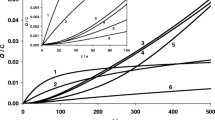Abstract
With the purpose of determining prospects of possible applications of interpolymer complexes of polyaniline (PANI) with poly(amidosulfonic acid)s, we have performed a comparative study of polyaniline films prepared by electrochemical polymerization of aniline in the presence of the polyacids distinguished by different rigidities of the polymer backbone: (1) poly(2-acrylamido-2-methyl-1-propanosulfonic acid) (flexible backbone); (2) poly-p,p′-(2,2′-disulfoacid)-diphenylen-iso-phthalamid (semi-rigid backbone); (3) poly-p,p′-(2,2′-disulfoacid)-diphelylen-tere-phthalamid (rigid backbone); and (4) a copolymer of the latter two acids with monomer feed ratio 1:1 (co-PASA). Spectroelectrochemical studies in the UV–vis–NIR range showed that PANI complexes with rigid-chain polyacids far more effectively modulate absorbance in the Vis–NIR range and can be considered as promising candidates for “smart windows” development. Due to the presence of bulky unmovable polyacid anion, PANI interpolymer complexes (particularly those with the semi-rigid-chain polyacids) possess much wider pH range of electroactivity than common PANI, which is of great importance for biosensor applications. The interpolymer complexes with flexible-chain and semi-rigid-chain polyacids exhibit good optical response to ammonia vapors at conditions of high humidity, which make them promising materials for the development of ammonia optical sensors.








Similar content being viewed by others
References
Gribkova OL, Nekrasov AA, Isakova AA, Ivanov VF, Vannikov AV (2006) Russ J Electrochem 42:1085–1092
Lyutov V, Georgiev G, Tsakova V (2009) Thin Solid Films 517:6681–6688
Bernard MC, Hugot-Legoff A (1999) Synth Met 102:1342–1345
Jelle BP, Hagen G (1999) Sol Energy Mat Sol Cells 58:277–286
De Paoli M-A, Nogueira AF, Machado DA, Longo C (2001) Electrochim Acta 46:4243–4249
Hechavarria L, Hu HL, Rincon ME (2003) Thin Sol Films 441:56–62
Trojanowicz M, Krawczyk TKV, Zmorzynska M, Campanella L (1997) Electroanalysis 9:1062–1066
Chabukswar VV, Pethkar S, Athawale AA (2001) Sens Actuat B 77:657–663
Nicho ME, Trejo M, Garciavalenzuela A, Saniger JM, Palacios J, Hu H (2001) Sens Actuat B 76:18–24
Christie S, Scorsone E, Persaud K, Kvasnik F (2003) Sens Actuat B 90:163–169
Simon E, Halliwell CM, Toh CS, Cass AEG, Bartlett PN (2002) Bioelectrochemistry 55:13–15
Yu X, Sotzing GA, Papadimitrakopoulos F, Rusling JF (2003) Anal Chem 75:4565–4571
Snejdarkova M, Svobodova L, Evtugyn G, Budnikov H, Karyakin A, Nikolelis DP, Hianik T (2004) Anal Chim Acta 514:79–88
Nekrasov AA, Gribkova OL, Eremina TV, Isakova AA, Ivanov VF, Tverskoj VA, Vannikov AV (2008) Electrochim Acta 53:3789–3797
Guseva MA, Isakova AA, Gribkova OL, Tverskoi VA, Ivanov VF, Vannikov AV, Fedotov YuA (2007) Polym Sci A 49:4–11
Sun L, Liu L-M, Clark R, Yang SC (1997) Synth Met 84:67–68
Kirsh YuE, Fedotov YuA, Iudina NN, Katalevskii EE (1990) Polym Sci B 32:403–404
Benyaich A, Deslouis C, ElMoustafid T, Musiani MM, Tribollet B (1996) Electrochim Acta 41:1781–1785
Pruneanu S, Csahók E, Kertész V, Inzelt G (1998) Electrochim Acta 43:2305–2323
Koziel K, Lapkowski M, Vieil E (1997) Synth Met 84:91–92
Rabinovich VA, ZYa K (1977) Kratkii khimicheskii spravochnik (Short chemical handbook). Khimiya, Moscow, p 271
Thieste D, Byker HJ, Baumann K, Srinivasa R (2001) US Patent 6,193,912
Granqvist CG (2002) Handbook of inorganic electrochromic materials. Elsevier Science B.V., Amsterdam, p 14 (Second impression)
Yang SC, Clark RL, Liao H, Sun L (1995) Proc SPIE 2528:198–208
Abd-Elwahed A, Holze R (2003) Russ J Electrochem 39:391–396
Łapkowski M, Pron A (2000) Synth Met 110:79–83
Nekrasov AA, Ivanov VF, Vannikov AV (2000) J Electroanal Chem 482:11–17
Huang W-S, Humphry BD, MacDiarmid AG (1986) J Chem Soc Faraday Trans 1 82:2385–2400
Hirai T, Kuwabata S, Yoneyama H (1989) J Chem Soc Faraday Trans 1(85):969–976
Yue J, Epstein AJ (1992) J Chem Soc Chem Commun 21:1540–1542
Kang Y, Lee MH, Rhee SB (1992) Synth Met 52:319–328
Tarver J, Yoo JE, Dennes TJ, Schwartz J, Loo Y-L (2009) Chem Mater 21:280–286
Jin Z, Su Y, Duan Y (2001) Sens Actuat B 72:75–79
Acknowledgments
This work was supported by the International Science and Technology Center, project ISTC 3718 and the Russian Foundation for Basic Research, grant 07-03-92176-NTsNI. The authors are very thankful to Prof. V.A. Tverskoj from Moscow State Academy of Fine Chemical Technology for providing us with the rigid-chain and semi-rigid-chain polymeric sulfonic acids used in this study.
Author information
Authors and Affiliations
Corresponding author
Rights and permissions
About this article
Cite this article
Nekrasov, A.A., Gribkova, O.L., Ivanov, V.F. et al. Electroactive films of interpolymer complexes of polyaniline with polyamidosulfonic acids: advantageous features in some possible applications. J Solid State Electrochem 14, 1975–1984 (2010). https://doi.org/10.1007/s10008-010-1057-1
Received:
Revised:
Accepted:
Published:
Issue Date:
DOI: https://doi.org/10.1007/s10008-010-1057-1




